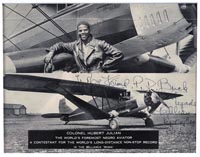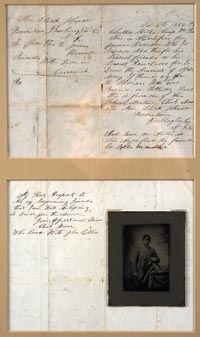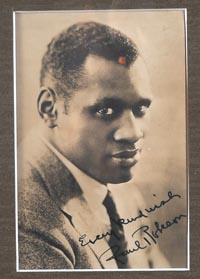
|
Sale 64
| Lot |
Photo |
Description |
Realized |
Lot 251 |
 |
Bluford, Guion S., Jr (1942 -) First African American astronaut; he has flown on four space flights. NASA Color Publicity Photograph Signed, "To John T. Evangelista with Best wishes from Guion S. Bluford, Jr. NASA Astronaut," 10 x 8 in., n.p., n.d. Fine.
Estimated Value $50 - 100.
View details and enlarged photo
| Realized
$25 |
Lot 252 |
 |
Douglass, Frederick (1817-95) Abolitionist, author, lecturer, and editor. Partly-printed Document Signed ("Fred.k Douglass") as Recorder of Deeds of the District of Columbia, Washington, DC, Jan. 4, 1883. The document is a release for a parcel of land in Washington, D.C. from trustee Otis Bigelow to William L. Marcy, his heirs, etc. Light overall toning and a few small ink stains on a blank portion of the document,which has been opened to 13 x 8½ in. and elaborately matted and framed so that both sides show. The document is housed in a hinged frame which is attached to a larger frame, 24½ x 26¾ in., containing an image of Douglass, a small name plaque and a large biographical plaque titled "The Black Lion of Cedar HIll." There are a few small nicks in the frame. Douglass was a former slave who became a leading abolitionist. He helped recruit black regiments and was consulted by Lincoln. An impressive display piece.
Estimated Value $800 - 1,000.
View details and enlarged photo
| Realized
$450 |
Lot 253 |
 |
Hughes, Langston. 7" x 5" Photograph Signed, "Sincerely -- Langston Hughes 1943,"7 x 5 in., n.p., n.d. A dapper chest-up photograph of the artist, who gained recognition with his poem "The Negro Speaks of Rivers," published in W.E.B. Du Bois' "Crisis" in 1921. Hughes was a major force of the Harlem Renaissance, emphasizing the need for both race pride and artistic independence. He not only wrote poetry, but also stories, novels, and plays, as well as an opera, "Street Scene," for which he wrote the lyrics with Kurt Weill. The multi-talented artist signed boldly across his chest. Matted and framed to 11¾ x 10 in.
Estimated Value $350 - 450.
View details and enlarged photo
| Realized
$390 |
Lot 254 |
 |
Juba Freeman, A Black Revolutionary Soldier, Receives His Pay. Partly-printed Document Signed, 6½ x 8 in., Hartford, Dec. 27, 1784. "Received of Pay-Table Committee, their Order on the Treasurer of this State, to secure the Payment of Twenty-Two Pounds nine shillings and nine Pence being the Balance due to Juba Freeman on the first Day of January 1784, as stated by the Committees of the State and of the Army." Richard Law, Freeman's former master, signs that he has received the Money "In behalf of Juba Freeman."
In 1777, Juba, a slave from Milford, Connecticut, enlisted in a segregated regiment of the Colony of Connecticut. A photocopy of Juba's enlistment (present) shows that half of Juba's pay went to his master, perhaps to purchase his freedom; that document was signed with Juba's mark as "Juba Negro." Following his emancipation, Juba took the name "Freeman" and is referred to by this name in the present document. Freeman is buried in Milford Cemetery.
The British promised runaways freedom for joining their ranks. American military leaders were reluctant at first to enlist African Americans, although black men had fought with the Continental Army at Concord, Lexington, and Bunker Hill. By war's end, some 5,000 black soldiers had fought for the American cause.
Estimated Value $600 - 800.
View details and enlarged photo
| Realized
$590 |
Lot 255 |
 |
Julian, Colonel Hubert (1897-1983) African American aviation pioneer. Black and White Print Photo Signed and Inscribed, "H Julian," 10 x 7½ in., Los Angeles, September 14, 1932. Two photographic images of Julian and his plane, the Bellanca 'Roma' arranged on a single, coated page, touting Julian as "The World's Foreost Negro Aviator / A Contestant for the World's Long-Distance Non-Stop Record." Some toning and one crease up top, else Fine. Matted and framed to 13 x 15¼ in.
Estimated Value $150 - 200.
View details and enlarged photo
| Unsold |
Lot 256 |
 |
[Letter Re Death of a Black Civil War Soldier - With Tintype. A poignant letter written Feb. 6, 1864 from Camp William Penn, Chilton Hills (PA) by black soldier Charles Moore reporting the death and burial of fellow soldier James Harrison, 2 pp, 8 x 5 in. Moore writes to Elick Johnson in Bordentown, N.J., asking that the letter be given to Moore's friends or relatives in Crosswick "for to Draw the Amount of State Mony if there is any…." A tintype of a black soldier is included. Folds, toning, and age wear, else Fine. Letter is matted with the tintype and a scan of the verso of page one in order to display entire contents and framed to 23¼ x 16½ in.
Estimated Value $600 - 800.
View details and enlarged photo
| Realized
$944 |
Lot 257 |
 |
Muhammed, Elijah (1897-1975) African American religious leader. Leader of the Nation of Islam (1934-75). Check Signed as leader of the Nation of Islam, 2¾ x 6¾ in., Chicago, IL, July 31, 1971. Engraved check from "The Honorable Elijah Muhammed's Poor Fund," paid to "Allendale" for $987.00. Red cancellation stamp does not touch Muhammed's strong signature. Very fine. Matted with a photo of Muhammed (considerable silvering to photo) and a printed article on "What the Muslims Want" and "What the Muslims Believe," all framed to an overall size of 19¾ x 26 in. Check is fine; frame has several nicks.
Estimated Value $400 - 600.
View details and enlarged photo
| Unsold |
Lot 258 |
 |
Robeson, Paul (1898-1976) American singer, actor, athlete, and political activist. Sepia-toned Photograph Signed and Inscribed, "Every kind wish Paul Robeson," 5 x 3½ in., n.p., n.d. Very Fine. Matted and framed to 10½ x 7½ in; a few nicks in the frame. Robeson appeared on stage ("Emperor Jones," "All God's Chillun," "Porgy," and "Othello"), in concert (Europe, America, and Russia) and in films ("Emperor Jones," "Saunders of the River," "Show Boat," and "The Proud Valley").
Estimated Value $250 - 350.
View details and enlarged photo
| Unsold |
Lot 259 |
 |
Slave Revolt Aboard the Brig Agent, January 20, 1811. Archive containing documents from the Brig Amelia, alias Agent, which was captured on May 16, 1811 at Cape Mount by Captain John Roach of the Brig Kitty of Liverpool. When Capt. Roach tried to board the Amelia, she hoisted Portuguese colors and threatened to fire. He boarded her with an armed crew, and discovered that she had left Charleston for Bahia as the Brig Agent on May 26, 1810, commanded by Captain Alexander Campbell, that she had been illegally fitted out in Portuguese colors, renamed Amelia, and bound for the coast of Angola to procure a cargo of slaves. She sailed from Cabenda (Sierra Leone) on January 1, bound for Havana, Cuba with a cargo of 275 slaves. On January 20, the slaves rose up and took possession of the brig, forcing the captain and most of the crew to take the boat and leave the ship; four crew members were kept to navigate the ship, which they did until May 14th, when she arrived at Cape Mount. Capt. Roach found that most of the slaves had perished from hunger. The 85 survivors were settled in a village west of Freetown, which they called New Cabenda.
This archive includes the following letters and documents which were found on the brig Agent by Captain Roach:
(1) The crew manifest, titled "Articles and Role d'Equipage," for the Brig Agent, Alexander Campbell Master, bound from the Port of Charleston, South Caroline for Bahia and back to any Port in the United States. Eleven crew members are named, along with their position, birth place, place of residence and citizenship, a physical description, and wages (listed for only three mariners). The crew included two Portuguese sailors, three slaves (one from South Carolina and two from Africa), and a free man. The slave from South Carolina, Jack White, was the leader of the slave revolt on Jan. 20, 1811. The captain and six men (not the slaves or free man), signed on the verso that they were the person in the printed agreement, witnessed by a notary public. Toning, a few small splits and holes.
(2) The Brig Agent's journal, with meticulous records kept by Captain Campbell of the ship's course, the winds, and the weather from May 26, 1810 until January 20, the last date of entry and the date of the slave revolt. Pages thereafter are blank. Top half of marbled paper cover is missing; pages are lightly toned; very neat and legible.
(3) Instructions to Buy Slaves - Manuscript Letter Signed by Francis Depau* to Capt. Campbell, 2½ pages, 13 x 8 in., Charleston, May 5, 1807. This letter was evidently written in 1807 while it was still legal to bring slaves into the United States (it became illegal on Jan. 1, 1808). In part: "Our ship Agent…being now ready for sea…you will proceed with all possible dispatch, to Mozambique, where you will purchase as many negroes as you think the ship can conveniently carry, which I reckon will be about three hundred…." He gives instructions on whom to contact to get the funds and says, "You must be very particular in the choice of the negroes & take care not to load your cargo with old people…& neither with too great a proportion of children…none under 13 years & lower than 4 feet 4 inches…." He gives instructions to "render their situation as comfortable as circumstances can admit" and to "let cleanliness on board be particularly attended…for the preservation of the health of your people…." He discusses provisions and hopes that Campbell will be back in Charleston before Jan. 1. Lower portion of page 3 is missing, affecting nothing. Toning and soiling. Very neat and legible.
(4) 1810 Letter Giving Instructions on How to Break the U. S. Law Prohibiting "the importation of slaves into any port or place within the jurisdiction of the United States." Manuscript Letter Signed by Francis Depau* to Capt. Campbell, 3 pages, 12¾ x 7½ in., Charleston, May 17, 1810. Giving orders to Capt. Campbell on how to put the ship under Portuguese colors in order to "qualify the Agent to bring a cargo from the Coast." With explicit instructions on how the law firm of Sealy, Roach & Foote of Bahia will help the captain break the law by finding an "honest" Portuguese merchant to arrange a "sham" sale of the brig and find the new crew members needed by law ("a Captain of Color one officer & part of the Crew"). The new "pretended owner" should instruct the Portuguese captain "not to interfere with the navigation…." All caution and secrecy is urged to prevent knowledge of "this business" from reaching the American consul or ambassador "as they might write home on the subject…let nothing transpire of your future plan & act as if you were only thinking of returning home…" Instructions are given on taking on a cargo in Bahia "fit for the Coast….Negroes are often very plenty there & if they can be bought from $80-$100 - I would just as well end the voyage there & give up the trip to Africa." More detailed money arrangements are discussed, then instructions are given on how to handle the American crew which will be dismissed with the "sale" of the Agent so that they won't be suspicious of the captain's future plan. There are also instructions on what to do with the ship's logbook and other papers, etc. Toning and soiling, but boldly penned.
The case of the slave ship Amelia, alias Agent, was one of several discussed at the March 25, 1812 Annual General Meeting of The African Institution, an anti-slavery group (1807-27), whose members included royalty, prominent lawyers, Members of Parliament, and well-known reformers such William Wilberforce. The entirety of the May 17, 1810 letter to Capt. Campbell was put in the records, as well as a deposition from a slave named Ned Brown, who was on board during the slave revolt and who described it as being started by a personal slave of the captain's, named Jack White (killed during the revolt), who had been flogged repeatedly by the captain (White is listed on the crew manifest in this archive). The report also gives Capt. Roach's depostion. (look on line at "The African Institution" to find this report.)
*Francis Depau, who wrote the two letters described, was a French native who emigrated to the United States by way of Haiti. He was the co-founder and principal owner of the first line of packet ships between New York and Le Havre around 1822.
Estimated Value $10,000 - 12,000.
View details and enlarged photo
| Realized
$13,570 |
Lot 260 |
 |
Washington, Booker T (1856-1915) Educator, author, and political leader. Manuscript Letter Signed as Principal of The Tuskegee Normal And Industrial Institute For The Training Of Colored Young Men And Women, on school letterhead, one page, 11 x 8½ in., Alabama, c. 1912. To Mr. Herbert Magoun of Boston, MA, asking for a donation: "If you can help us in any measure, however small, to meet the cost of tuition, we shall be very grateful." He notes that students pay for their board partly in work and partly in cash, but the cost of teaching is not covered by the school's endowment. Because of Washington's leadership, by the time of his death in 1915, Tuskegee had over 100 buildings, a faculty of about 200, a student body of 1500, and an endowment of $2 million. He was also the author of "Up From Slavery." Boldly signed. Matted and framed to 16½ x 15½ in.
Estimated Value $250 - 350.
View details and enlarged photo
| Realized
$192 |
|
|